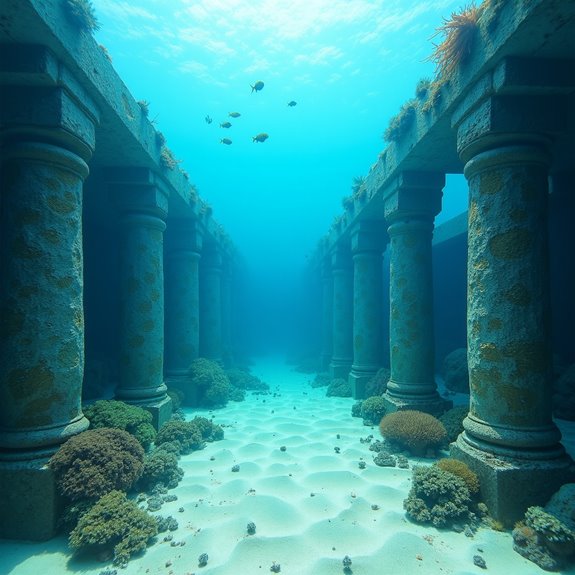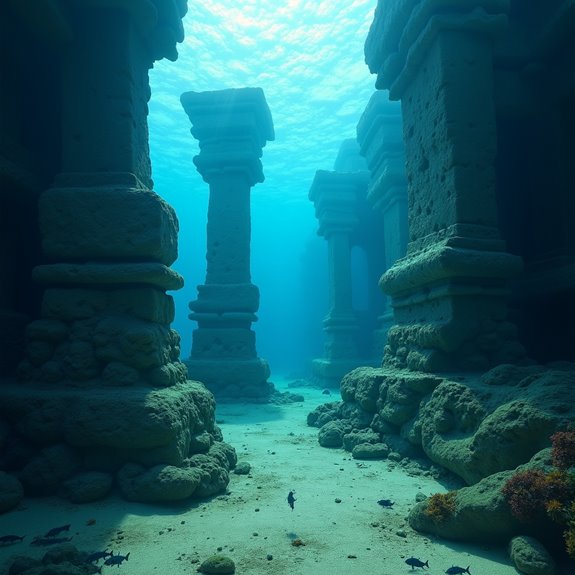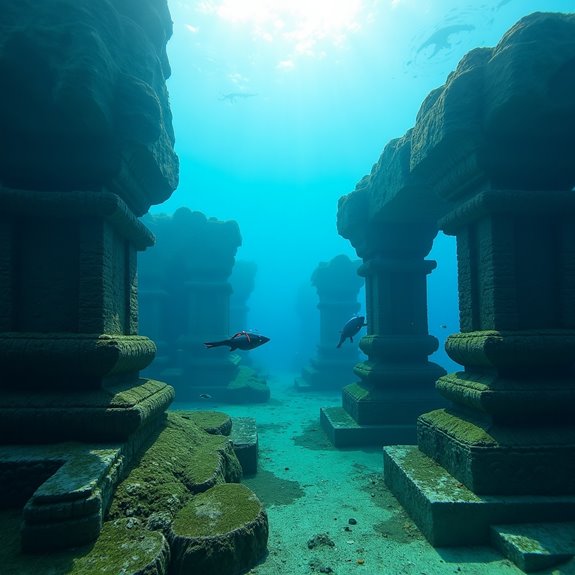Are There Sunken Temples Off the Coast of Japan?
Off the coast of Japan, particularly near Yonaguni and Okinawa, intriguing reports have emerged about sunken temples and mysterious underwater structures. These formations, resembling ancient pathways and massive stone blocks, have captured the interest of historians and divers alike. While many theories abound regarding their origins, the exploration of these sites raises questions about lost civilizations and their histories. What secrets might these submerged relics hold, and what further discoveries could reshape our understanding of the past?
Introduction

As scientists and archaeologists explore the mysteries of Japan’s past, they’ve uncovered intriguing sunken temples that whisper stories of ancient civilizations. These submerged sites, often shrouded in myth and legend, hint at a rich history filled with cultural significance. Many believe these structures were once vibrant places of worship and communal gatherings, now resting silently beneath the waves. The allure of these underwater relics captivates historians and divers alike, sparking curiosity about their origins and the circumstances that led to their submersion. Local legends and historical records intertwine, offering clues to the lives of the people who once inhabited these regions. As exploration continues, new discoveries promise to deepen understanding of Japan’s maritime heritage and its connection to the wider world.
Ancient Underwater Structures Discovered

Recent explorations have led to the discovery of remarkable ancient underwater structures off Japan’s coast. These findings excite archaeologists and historians alike, as they reveal traces of an advanced civilization that once thrived in the region. Through advanced sonar technology and underwater drones, researchers have identified formations resembling large stone blocks, pathways, and even possible remnants of shelters. These structures, submerged for centuries, offer insights into the architectural prowess and cultural practices of the people who built them. The surrounding marine environment has preserved these artifacts remarkably well, leading to a wealth of potential knowledge regarding ancient maritime activities. As further investigations continue, these discoveries could reshape our understanding of Japan’s historical development and its connection to the ocean.
Notable Cases or Sightings

Numerous notable cases have emerged from the exploration of underwater structures off Japan’s coast, capturing the attention of researchers and adventurers alike. One prominent example is the discovery near Yonaguni, where a series of massive stone formations have sparked debate about their origins. Another sighting occurred in the waters around Okinawa, where divers reported what appeared to be giant, submerged stairs leading to an unseen entrance. In addition, local fishermen often recount tales of strange, ancient walls beneath the waves, igniting curiosity and intrigue. The ongoing investigations into these underwater mysteries offer potential insights into Japan’s ancient civilizations, leaving many to wonder what secrets still lie hidden in the depths of the surrounding sea.
Common Theories or Explanations
Intriguing findings in Japan’s underwater landscapes have led to various theories regarding their origins. Some believe these structures are remnants of ancient civilizations that faced catastrophic events, leading to their submersion. Others suggest the formations are natural geology, shaped by centuries of erosion and tectonic activity. The alignment of certain structures with celestial bodies has fueled speculation about their potential astronomical significance. Furthermore, some theorists argue these underwater sites could be religious or ceremonial remnants, aimed at honoring deities or facilitating spiritual practices. While each theory offers compelling arguments, definitive evidence remains elusive, prompting ongoing investigations. As research continues, the mystery surrounding these submerged sites deepens, fascinating both archaeologists and enthusiasts alike.
Frequently Asked Questions
What Technologies Are Used to Explore Underwater Structures in Japan?
Japan employs advanced sonar mapping, remotely operated vehicles (ROVs), and underwater drones to explore underwater structures. These technologies enhance visibility and provide detailed data, enabling researchers to discover and study submerged sites effectively and accurately.
Are There Any Archaeological Teams Studying These Submerged Temples?
Yes, several archaeological teams are studying submerged temples in various locations. They’ve employed advanced technologies like sonar mapping and underwater robotics, uncovering significant historical insights while ensuring careful preservation of these underwater sites.
How Do Local Legends Relate to the Sunken Temples?
Local legends often intertwine with the sunken temples, suggesting they symbolize lost civilizations and divine punishment. They inspire tales of mysterious events, guiding explorers and archaeologists to discover deeper cultural meanings hidden beneath the waves.
What Marine Life Inhabits the Areas Around These Underwater Sites?
The areas around these underwater sites teem with diverse marine life. Colorful coral reefs attract vibrant fish, while larger species like sharks patrol the depths. Local waters’ richness fosters unique ecosystems, highlighting nature’s resilience and beauty.
Have Any Artifacts Been Recovered From These Submerged Temples?
They’ve recovered various artifacts from the submerged temples, including pottery, statues, and tools. Each discovery provides insight into the historical significance of these underwater sites and enriches the understanding of the culture that created them.


